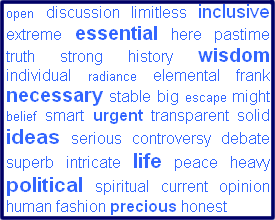
There is an exciting article in the New York Times today on tagging, folksonomy and on line art collections. One Picture, 1,000 Tags.
What happens when you let the public tag art?
We would never say a work is mostly red, or instills a sense of ennui, or features a dog playing poker,†agreed Bruce Wyman, director of new technologies for the Denver Art Museum. “Tagging gives us a set of eyes we don’t have.â€
“Our keywording was insufficient in a lot of ways,†said Effie Kapsalis, senior digital producer of the site. “There’s no taxonomic system that could cover the subjects of all these photographs. And we want a lot of tags for each image. So that’s why we turned to the public.â€
“The results were staggering,†said Susan Chun, general manager for collections information planning at the Met. “There’s a huge semantic gap between museums and the public.â€
I’m thrilled with the work that is happening around the steve.museum project. For example, explore the Powerhouse Museum’s online collection and see the ability to add keywords to any image.
Now I’m dreaming of how wonderful the world would be if we could have Google Art. I mean if Google can take on the concept of creating the digital library…why not do the same for the visual arts. Okay…so it is huge. But close your eyes and imagine if it were a reality. Imagine it was searchable, taggable, and helped you discover new artists you never knew about. Imagine if you could share your travel plans with GoogleArt and it could let you know about delicious small galleries you could visit on your next business trip. What if you could create an online digital collection and have it stream to your flatpanel TV screen…filling your living room with images of priceless art.
Does this cheapen art…or deepen your personal relationship with it? Does it make you never need to step foot in another museum…or does it make art and musuems so much a part of your everyday life that you find yourself drawn more and more to the physical galleries…because nothing, nothing is more powerful than standing in front of the original work of art?
(sigh)
Do you realize the amount of control that would require stakeholders (librarians, curators, university marketing depts., etc.) to give up? I love it. It doesn’t cheapen art; it makes the experience much much more personal.
Personal, and accessible to fun little (and big) packs of viewers who will make only the sense out of the work that they choose to anyway.